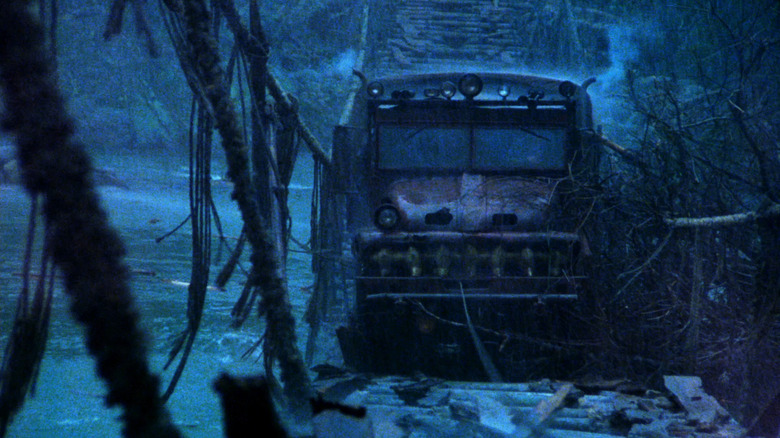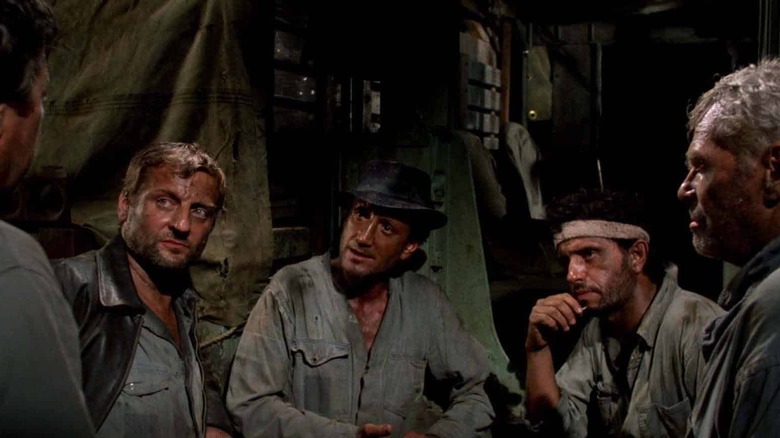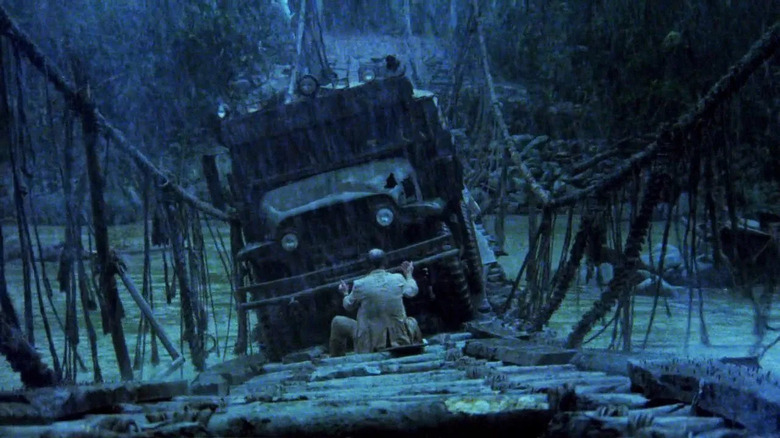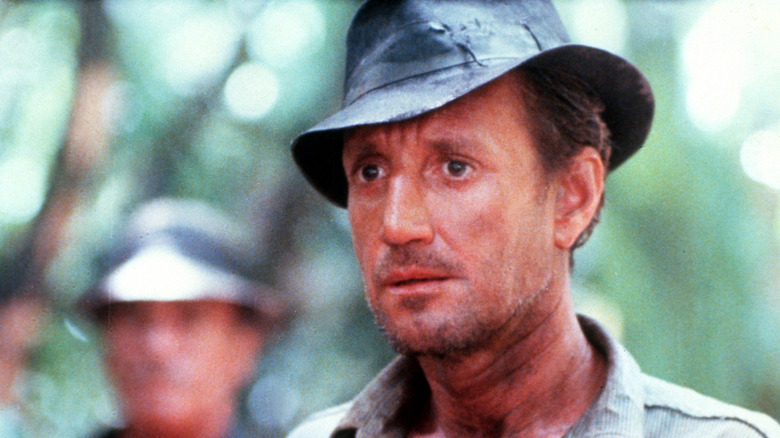Sorcerer Director William Friedkin Fell In The Water During The Film's Most Harrowing Stunt
William Friedkin had a great run in the '70s. His hard-nosed police thriller "The French Connection" dominated the 1972 Oscars, winning five Academy Awards including the big prizes for Best Picture, Director, and Actor for Gene Hackman. He followed that critical and commercial success with "The Exorcist," which courted controversy but nevertheless became a box office smash and the first horror movie to receive an Oscar nomination for Best Picture. It also secured a second Best Director nomination for Friedkin.
He might have made it three in a row with "Sorcerer," his gripping remake of Henri-Georges Clouzot's 1953 suspense thriller "The Wages of Fear," if it wasn't for bad timing. It had the misfortune to be released in 1977 a month after "Star Wars," which was smashing it at the box office and well on its way to becoming a global phenomenon. As audiences were swept away by George Lucas's brand of escapist space fantasy, they were perhaps not in the mood to have their buzz killed by a sweaty, gritty tale of four desperate men trying to transport a dangerous cargo through the South American jungle. It also suffered due to the title: After the demonic goings-on of "The Exorcist," many cinema-goers saw the name "Sorcerer" and expected more of the same, forcing distributors to add the disclaimer "Not a film about the supernatural" to the marketing material.
The film was a notorious box office flop, pulling in just $12 million worldwide versus a budget of $22 million. Luckily, "Sorcerer" developed a cult following and it is now rightly regarded as Friedkin's third back-to-back masterpiece, a bleak and nihilistic thriller with one of the most suspenseful scenes in cinema history. Friedkin put his own safety on the line to capture that famous moment, living out the deadly situation in the rain forests of Mexico.
The set up
"Sorcerer" opens in disorienting fashion with four globetrotting vignettes that introduce the principal characters. In Mexico, hitman Nilo (Francisco Rabal) calmly walks into an apartment and guns down his target. In Israel, a group of Palestinians engineer a terrorist attack in Jerusalem and are rounded up by the Israeli Defence Forces; only Kassem (Amidou) manages to escape. Wealthy Parisian banker Victor Manzon (Bruno Cremer) faces financial ruin and jail time when he is charged with fraud, causing him to flee the country and leave his cosmopolitan lifestyle and glamorous wife behind. Lastly, Jackie Scanlon (Roy Scheider), a New Jersey crook, is forced to go on the lam from the mob after a robbery goes disastrously wrong.
Assuming fake identities and living in self-exile from their home countries, all four men find themselves hiding out in a small village in Colombia. It's a miserable and dangerous existence, scraping a meager income and constantly looking over their shoulder. They are trapped, too poor to afford a better life anywhere else. In desperation, they take a hazardous job from a large American oil company that is integral to the region's economy. An oil well has exploded and the only way to contain the fire is to seal the breach with dynamite. The only source of explosives is a cachet of badly stored and dangerously unstable nitroglycerin held in a remote outpost over 200 miles away.
The company needs four drivers prepared to risk their lives transporting the deadly cargo in two heavy-duty trucks, knowing full well that the slightest vibration could cause the sticks to explode. The route ahead is treacherous and fraught with potential disaster as they negotiate thick jungle, fallen trees, bandits, tropical storms, and a river crossing over a very old rope bridge.
The bridge scene
William Friedkin made a name for himself as an uncompromising director with unconventional methods during his peak period in the '70s. For the thrilling chase scene in "The French Connection" where Popeye Doyle (Gene Hackman) pursues an elevated train through the streets of New York, he recklessly mounted his cameras on a car and instructed his stunt driver to hurtle through Brooklyn at high speed, endangering the lives of real pedestrians and motorists.
After that, Friedkin took the unusual directorial approach of firing a gun on set while filming "The Exorcist" to keep his actors believably on edge. Ellen Burstyn also injured her spine thanks to a setup involving a wire yanking her to the floor in one scene; she blamed Friedkin for not taking her safety concerns into full consideration.
The director was similarly hands-on for the showpiece bridge scene in "Sorcerer." By the time we reach the scene, he has already got us on the edge of our seats by establishing that the dynamite could go off with the slightest jolt. The river crossing looks impossible: the rope bridge looks in even worse condition than the one in "Indiana Jones and the Temple of Doom," swaying over the rising waters as the storm rages around the drivers and their trucks. The characters aren't the most sympathetic, but Friedkin has such assured control of his material that the tension is almost unbearable as they inch their deadly payload over the rotten planks of the bridge.
Safety precautions were cleverly built in, including steel cables disguised as decaying ropes and a hydraulic device controlling the motion of the bridge and the trucks. But there is no escaping the fact that these are real trucks with real actors, filmed crossing a real river on a real bridge, and the danger involved was also very genuine.
William Friedkin ended up in the water filming the famous scene
The bridge scene in "Sorcerer" was filmed on location in Mexico after William Friedkin's first-choice river in the Dominican Republic dried up, and the director suffered for his art along with his crew. Despite the safety precautions put in place, the trucks still ended up in the water. As Friedkin explained during a Q&A:
"Each truck fell off [the bridge] about five or six times. I was in it at least twice that I remember, and probably a time that I don't remember. When the film was finished, I had malaria and half the crew got gangrene or a lot of serious after-effects. And yes, it was an adventure... but it's not one I'd go through again."
The scene is a miracle of gung-ho filmmaking. Friedkin lets the suspense draw out, combining the dangerous practical stunts with atmospheric sound design that puts us right in the middle of the tempest with the characters. You can feel the physical weight of the trucks bearing down on the sodden boards of the bridge until they're ready to snap. When I first saw the film, I jumped out of my skin and gave a little yelp when one finally does.
There is clearly no way the scene would be filmed in such a way today as CGI would inevitably stand in to reduce costs and danger. In that regard, "Sorcerer" is a relic from a more buccaneering era when directors would head off to far-flung locations to attempt the ridiculous. Francis Ford Coppola re-staged the Vietnam War in the Phillippines with real military equipment for "Apocalypse Now," and Werner Herzog, having already spent time in the Peruvian rainforest making "Aguirre, Wrath of God," went back to South America to drag a real boat across a real hill in "Fitzcarraldo." Likewise, William Friedkin was ready to put everything on the line to achieve just a few minutes of pure suspense.



